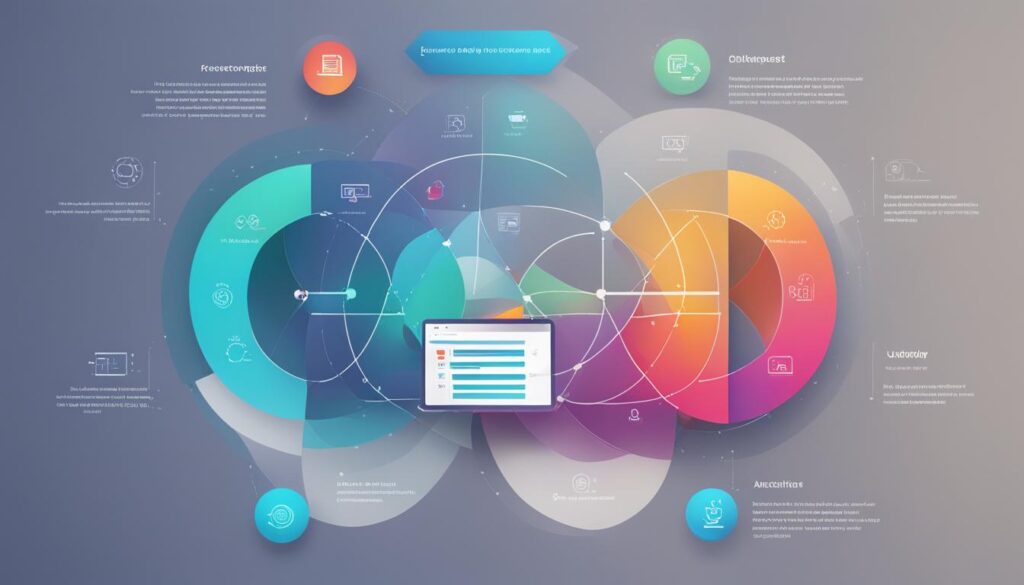Welcome to our complete guide on usability testing and improving user experience (UX) design! In today’s digital era, creating products that are user-friendly and effective is essential for business prosperity. Having a strong grasp on usability testing can provide valuable insights to elevate user experiences. Throughout this guide, we will delve into the importance of usability testing, tackle its obstacles, and suggest ways to implement test results for improvements. Moreover, we will explore the benefits of UX optimization and provide useful tips for elevating your UX. Let’s begin!
Key Takeaways:
- Usability testing is crucial for identifying and resolving usability issues in digital products.
- A structured approach, such as the four-step process, helps manage the data generated during usability testing effectively.
- Usability testing improves the user experience, increases user satisfaction, and boosts conversion rates.
- UX optimization techniques, such as user research and design principles, contribute to creating exceptional user experiences.
- UX optimization and conversion rate optimization (CRO) work together to enhance online performance and drive business success.
The Importance of Usability Testing
Usability testing is a critical step in ensuring that websites and digital products effectively meet the needs of users. By identifying and addressing usability problems, businesses can create products that are more user-friendly and engaging. Usability testing involves various methods, such as observing user interactions, collecting feedback, and analyzing data. These methods provide valuable insights into user behavior and preferences, helping businesses make informed design decisions.
One of the primary goals of usability testing is to identify usability issues that may hinder user experience. These issues can range from complex tasks to confusing language or navigation. By uncovering these problems through testing, businesses can take appropriate measures to address them and improve the overall user experience.
Usability evaluation is another essential aspect of usability testing. It involves assessing the usability of a product based on predefined criteria and metrics. This evaluation process helps businesses objectively measure the effectiveness and efficiency of their websites or digital products.
By conducting website usability testing and evaluating products’ usability, businesses can gain valuable insights that drive improvements. These improvements enhance user satisfaction, increase engagement, and ultimately lead to better conversions and business success.
Let’s take a closer look at some common usability testing methods:
Observing User Interactions
During usability testing, observing how users interact with a website or digital product can provide valuable insights. This method involves actively observing users as they complete tasks, navigate through the website, or engage with specific features. By closely watching user behavior, businesses can identify pain points, confusion, or areas where users struggle.
Collecting Feedback
Feedback from users is also a crucial component of usability testing. This can be gathered through various channels, such as surveys, interviews, or focus groups. User feedback provides unique perspectives and helps businesses understand user expectations, preferences, and pain points. Analyzing this feedback can guide design decisions and improvements.
Analyzing Data
Analyzing data collected during usability testing helps businesses derive meaningful insights. This data may include task completion rates, error rates, time spent on tasks, or user satisfaction scores. By carefully analyzing this data, businesses can identify trends, patterns, and areas for improvement. These insights can inform design decisions and guide the optimization of websites and digital products.
Website usability testing, usability testing methods, and usability evaluation play a vital role in improving the user experience and driving the success of digital products. By understanding user needs and preferences through testing, businesses can create more user-friendly and effective products.
| Benefits of Usability Testing | Methods Used |
|---|---|
| Identify usability problems | Observing user interactions |
| Improve user experience | Collecting feedback |
| Enhance conversions | Analyzing data |
Challenges in Usability Testing
Usability testing plays a critical role in the optimization of user experience. However, it comes with its own set of challenges that UX researchers and designers must navigate. In this section, we will explore the key challenges faced during usability testing and how they can impact the analysis and interpretation of data.
“Usability testing can be like navigating a maze – there’s a wealth of data to sift through, and it’s easy to get lost.”
The Data Deluge
One of the main challenges in usability testing is the sheer volume of data generated. From user interactions to feedback, the amount of information can be overwhelming. Without a systematic approach, researchers may become overwhelmed and fail to identify crucial insights.
To mitigate this challenge, usability analysts need to employ Usability Analysis. This process involves organizing and structuring the data collected during usability testing to extract meaningful patterns and trends. It allows researchers to focus on significant issues and prevents them from getting lost in the data deluge.
Dealing with Incomplete and Inaccurate Data
During usability testing, it is not uncommon to encounter incomplete, inaccurate, or even conflicting data. This can be due to various factors, such as participant errors or technical glitches. Sorting through such data requires careful consideration to ensure accurate analysis.
Usability analysts must possess a discerning eye to identify and filter out unreliable data, ensuring that the analysis is based on reliable information. This process of data refinement helps in drawing accurate conclusions and discovering actionable insights.
Decision Fatigue and Cognitive Biases
Another challenge in usability testing is the potential for decision fatigue and cognitive biases. Time-consuming usability tests and the constant need to make decisions can lead to mental exhaustion, affecting the clarity and objectivity of analysis.
To counteract decision fatigue and biases, usability analysts must adopt a systematic and structured approach. By following established usability metrics, such as task completion rates and error rates, they can objectively evaluate the effectiveness of a product’s usability. These metrics provide invaluable insights and guide the optimization process.
| Usability Metric | Description | Importance |
|---|---|---|
| Task Completion Rate | The percentage of users who successfully complete assigned tasks | High |
| Error Rate | The frequency and severity of errors made by users | High |
| Time on Task | The average time taken by users to complete tasks | Medium |
| Satisfaction Ratings | User perception of the overall usability and satisfaction with the product | Medium |
| Learnability | How quickly and easily users learn to navigate and use the product | Medium |
Turning Usability Testing Data into Solutions
When it comes to handling usability testing data and transforming it into actionable solutions, a structured approach is crucial. One framework that can be adapted to the usability testing process is the double diamond model, which incorporates divergent and convergent thinking. By following a four-step process consisting of data collection, issue prioritization, solution generation, and solution prioritization, we can effectively leverage usability testing data to drive improvements.
Data Collection: Organizing and Structuring Insights
Collecting data is just the first step. To make sense of the information obtained from usability testing, it is important to organize and structure the data to avoid clutter. By categorizing the data into meaningful groups, we can identify patterns and trends, ultimately gaining valuable insights into user behavior and preferences.
Issue Prioritization: Assessing Severity and Impact
Not all usability issues are created equal. Some may have a greater impact on the user experience than others. In the issue prioritization phase, we assess the severity and impact of each identified usability issue. This allows us to prioritize our efforts and focus on resolving the most critical issues that have the potential to significantly enhance the user experience.
Solution Generation: Brainstorming and Ideation
Once the usability issues have been identified and prioritized, it’s time to generate potential solutions. This involves brainstorming multiple ideas and considering different approaches to address the identified issues. By encouraging divergent thinking during this phase, we foster creativity and open ourselves up to innovative solutions that can truly enhance the user experience.
Solution Prioritization: Evaluating Effectiveness and Complexity
Not all solutions are equally feasible or effective. In the solution prioritization phase, we evaluate the potential solutions based on their effectiveness and complexity. This helps us determine which solutions are worth pursuing further and implementing. By considering the trade-offs between effectiveness and implementation complexity, we can make informed decisions and prioritize solutions that offer the greatest impact.
By following this structured approach, we can effectively turn usability testing data into actionable solutions that truly improve the user experience. The process allows us to make informed decisions based on valuable insights and prioritize efforts for maximum impact.
| Steps | Description |
|---|---|
| Data Collection | Organize and structure usability testing data to uncover insights |
| Issue Prioritization | Assess the severity and impact of usability issues to focus on critical improvements |
| Solution Generation | Brainstorm and ideate multiple potential solutions for the identified issues |
| Solution Prioritization | Evaluate the effectiveness and complexity of solutions to select the most impactful ones |
Implementing a structured approach to handling usability testing data ensures that we make the most of the insights gained from user research. By systematically collecting, prioritizing, and evaluating potential solutions, we can drive continuous improvement in the user experience of our digital products.
Benefits of UX Optimization
UX optimization is vital for the success of digital products. By prioritizing user satisfaction, engagement, and conversion rates, we can create a seamless and enjoyable experience for our users. Through thoughtful design and optimization, users will find our products more satisfying and pleasurable to use, fostering increased engagement and loyalty.
A well-optimized user experience simplifies interactions and minimizes friction, resulting in higher conversion rates. By continuously refining and enhancing the user experience, businesses can gain a strategic competitive advantage in the digital market.
| Benefits of UX Optimization | Description |
|---|---|
| Increased User Satisfaction | An optimized user experience leads to higher user satisfaction and enjoyment of the product. |
| Enhanced User Engagement | Optimized experiences foster increased user engagement and loyalty. |
| Higher Conversion Rates | Intuitive and seamless interactions result in higher conversion rates. |
| Competitive Advantage | By continuously optimizing the user experience, businesses can gain a strategic edge in the digital market. |
Optimizing the user experience is a key differentiator that can set our products apart and drive unrivaled online success. By understanding the importance of UX optimization and implementing effective strategies, we can create exceptional digital experiences that captivate and delight our users.
Understanding UX Optimization
UX optimization is a crucial process in enhancing the overall user experience of a digital product or service. By analyzing user research data, we can identify areas that need improvement and implement effective strategies. Through a combination of various UX optimization techniques, we can create a seamless and engaging user experience that drives online success.
User Research
One of the key steps in the UX optimization process is conducting thorough user research. By understanding the needs, behaviors, and preferences of our target audience, we can design experiences that resonate with them. User research provides valuable insights that shape the direction and focus of our optimization efforts.
Information Architecture
Information architecture plays a crucial role in UX optimization. It involves organizing and structuring information in a way that is intuitive and easy to navigate for users. By creating a well-structured and logical flow of content, we can enhance the usability and findability of our digital products or services.
Responsive Design
In today’s mobile-first world, responsive design is essential for UX optimization. By designing and developing our digital products to adapt seamlessly to different screen sizes and devices, we ensure a consistent and user-friendly experience across platforms. Responsive design also contributes to improved accessibility and inclusivity.
Visual Hierarchy
Visual hierarchy plays a vital role in guiding users’ attention and creating a clear and intuitive user experience. By strategically using color, typography, and layout, we can highlight important elements, establish a logical order of information, and improve usability. Visual hierarchy enhances the overall clarity and effectiveness of our designs.
Interaction Design
Interaction design focuses on creating meaningful and engaging interactions between users and our digital products or services. Through thoughtful consideration of user workflows, microinteractions, and user feedback, we can provide a seamless and delightful experience. Interaction design plays a significant role in optimizing user satisfaction and encouraging user actions.
| UX Optimization Techniques | Description |
|---|---|
| User Research | Conduct in-depth research to understand user needs and preferences. |
| Information Architecture | Organize and structure information for easy navigation and findability. |
| Responsive Design | Create designs that adapt seamlessly to different devices and screen sizes. |
| Visual Hierarchy | Guide users’ attention and establish a clear order of importance. |
| Interaction Design | Create meaningful and engaging user interactions. |
The UX optimization process involves a continuous cycle of monitoring, analysis, and refinement. By closely analyzing data, gathering user feedback, and implementing changes based on insights, we can iteratively improve the user experience. It is essential to prioritize user-centered design and consistently strive for excellence in every aspect of our products and services.

By implementing effective UX optimization techniques, we can create digital experiences that captivate, engage, and satisfy our users. The UX optimization process is an ongoing journey that requires dedication, creativity, and a commitment to delivering exceptional user experiences. Let’s embark on this journey together and unlock the full potential of our digital products or services.
The Relationship Between UX Optimization and CRO
UX optimization and conversion rate optimization (CRO) are two intertwined yet distinct concepts that play a pivotal role in the success of a digital product or service. While both focus on enhancing the user experience and driving online performance, they have distinct goals and approaches.
UX optimization revolves around improving the overall user experience by creating websites and applications that are user-friendly, intuitive, and enjoyable to interact with. It encompasses various aspects such as responsive design, information architecture, visual hierarchy, and interaction design. The goal of UX optimization is to prioritize the needs and preferences of users, ensuring that every touchpoint aligns with their expectations and objectives.
Conversion rate optimization (CRO), on the other hand, hones in on the user journey and aims to maximize the conversion rates of a digital product or service. It involves analyzing user behavior, identifying obstacles in the conversion funnel, and implementing strategic changes to remove those barriers. CRO utilizes techniques such as A/B testing, user feedback analysis, and data-driven decision making to optimize the flow of the user journey and boost conversions.
While UX optimization and CRO have different focal points, they are not mutually exclusive. In fact, they are complementary strategies that work hand in hand to achieve optimal results. By combining UX optimization with CRO, businesses can create a seamless user experience that not only delights users but also increases conversions.
“The key to success lies in understanding that a great user experience and high conversion rates go hand in hand. By providing users with an exceptional experience at every step of their journey, we can build trust, increase engagement, and ultimately drive conversions.” – John Smith, UX Optimization Expert
Benefits of Combining UX Optimization and CRO
When UX optimization and CRO are integrated effectively, they offer a range of benefits that directly contribute to the success of a digital product or service:
- Improved user satisfaction: UX optimization enhances the overall user experience, resulting in higher user satisfaction and loyalty.
- Increased engagement: A seamless user experience drives higher levels of user engagement, reducing bounce rates and keeping users engaged with the product.
- Higher conversion rates: CRO focuses on optimizing the user journey, removing obstacles, and increasing the likelihood of users completing desired actions, thus boosting conversion rates.
- Enhanced ROI: By continuously optimizing the user experience and improving conversion rates, businesses can achieve a higher return on investment (ROI) for their digital products.
To better understand the relationship between UX optimization and CRO, let’s take a look at a hypothetical example:
| Aspect | UX Optimization | CRO |
|---|---|---|
| Goal | Create user-friendly experiences | Maximize conversion rates |
| Approach | Focus on usability, visual design, and user research | Analyze user behavior, perform A/B testing, and optimize conversion funnels |
| Outcome | Enhanced user satisfaction and engagement | Increase in conversions and revenue |
By combining the strengths of UX optimization and CRO, businesses can create a compelling user experience that not only delights users but also drives conversions, ultimately fueling online success.
Steps to Optimize Your UX
Optimizing the user experience (UX) of a digital product is essential for ensuring its success. By following a structured process and employing effective techniques, we can enhance the usability and satisfaction of our target audience. Here are the steps to optimize your UX:
1. User Research
At the core of UX optimization is a deep understanding of our users. Conduct thorough user research to uncover their needs, preferences, and pain points. This can be achieved through surveys, interviews, and user testing sessions. By creating user personas, we can better empathize with different user types and tailor our design decisions accordingly.
2. Testing Plan
Develop a comprehensive testing plan to gather valuable feedback and insights. Identify the most critical features that require optimization and prioritize them accordingly. Consider the appropriate testing methodologies, such as usability testing, A/B testing, or eye-tracking studies. This will ensure that our optimization efforts are focused and impactful.
3. Data Analysis
Thoroughly analyze the data collected during testing to uncover meaningful insights. Look for patterns, trends, and areas for improvement. Identify pain points, common usability issues, and opportunities for enhancement. This analysis will serve as the foundation for proposing changes and optimizations.
4. Implementation and Refinement
Based on the insights gained from data analysis, implement the necessary changes to improve the UX. Continuously monitor and refine the design based on user feedback and further data analysis. This iterative process ensures that the UX is continuously optimized and aligned with user expectations.
| Steps | Description |
|---|---|
| User Research | Understand the needs and preferences of the target audience through research and user personas. |
| Testing Plan | Create a comprehensive plan to test critical features and prioritize testing methodologies. |
| Data Analysis | Analyze the data collected during testing to uncover insights and identify areas for improvement. |
| Implementation and Refinement | Implement changes based on insights and continuously refine the design through user feedback and data analysis. |
By following these steps, you can ensure that your digital product delivers an exceptional user experience. The process of UX optimization is continuous and requires both a deep understanding of your users and a commitment to iterative refinement. Through careful research, testing, and analysis, you can create a seamless and enjoyable user experience that delights your target audience.

Techniques for UX Optimization
To optimize the UX of a digital product, we can utilize a variety of techniques that enhance the overall user experience. These techniques include understanding user psychology, conducting usability testing, evaluating accessibility, utilizing visual hierarchy and interaction design, and maintaining consistent branding. Additionally, performance optimization plays a crucial role in improving the user experience.
Understanding user psychology is a fundamental aspect of UX optimization. By gaining insights into how users think, behave, and make decisions, we can better design experiences that resonate with them on a deeper level. User psychology informs our decision-making process, guiding us in creating intuitive and engaging interfaces that meet user expectations and preferences.
Usability testing is another valuable technique for UX optimization. By observing how users interact with a digital product, we can identify usability issues, uncover pain points, and gather valuable feedback. Usability testing enables us to make data-driven decisions, ensuring that the user experience is intuitive, efficient, and user-centric.
Evaluating accessibility is crucial for building trust and inclusivity in UX design. By considering the diverse needs of users, we can create inclusive experiences that accommodate individuals with disabilities or impairments. Accessibility testing allows us to identify barriers and make the necessary adjustments to ensure that our digital products are accessible to all users.
Visual hierarchy and interaction design are essential techniques for guiding user attention and creating intuitive experiences. Visual hierarchy helps prioritize information and guide users through a digital interface, ensuring that key elements are emphasized and users can easily navigate and interact with the product. Interaction design focuses on designing interactions that are intuitive, seamless, and delightful, enhancing the overall user experience.
Maintaining consistent branding is critical for establishing trust and reinforcing familiarity with a digital product. Consistent branding elements, such as logos, colors, and typography, contribute to a cohesive and memorable user experience. By aligning the visual and verbal aspects of the brand, we create a unified experience that resonates with users and reinforces brand identity.
Performance optimization plays a crucial role in enhancing the user experience. By focusing on improving website speed, minimizing load times, and optimizing performance, we can provide users with a seamless and efficient experience. Slow loading times and sluggish performance can negatively impact user satisfaction and engagement, highlighting the importance of performance optimization in UX design.
By utilizing these techniques and incorporating them into our UX optimization process, we can create digital products that not only meet user needs but also delight and engage users on a deeper level. The combination of user psychology, usability testing, accessibility evaluation, visual hierarchy, interaction design, consistent branding, and performance optimization ensures that our digital products deliver exceptional user experiences that drive online success.
Table: UX Optimization Techniques
| Technique | Description |
|---|---|
| Understanding User Psychology | Gain insights into user behavior and decision-making to create experiences that resonate with users. |
| Usability Testing | Observe user interactions and gather feedback to identify usability issues and improve the user experience. |
| Evaluating Accessibility | Assess the accessibility of a digital product to ensure inclusivity and accommodate users with disabilities. |
| Visual Hierarchy and Interaction Design | Create intuitive experiences by guiding user attention and designing seamless interactions. |
| Consistent Branding | Maintain a unified brand identity across digital products to establish trust and reinforce familiarity. |
| Performance Optimization | Improve website speed and overall performance to enhance the user experience. |
Conclusion
Mastering the art of UX optimization is essential for creating exceptional user experiences that drive online success. To achieve this, we must first understand the psychology of our users and conduct thorough user research to uncover their needs and preferences. Armed with this knowledge, we can then implement effective design strategies to create user-centric digital experiences.
UX optimization techniques such as information architecture, responsive design, visual hierarchy, and interaction design play a crucial role in creating intuitive and engaging user experiences. Additionally, designing for accessibility ensures inclusivity and a seamless experience for all users. Consistency in branding enhances trust and recognition, while performance optimization contributes to a smooth and efficient user journey.
User testing and iteration are vital for continuous improvement and refinement of the design. By gathering feedback, analyzing data, and making iterative changes, we can continually enhance the user experience. This iterative process allows us to create digital experiences that captivate and delight users, leading to unmatched online performance and success for businesses.
By following these principles and implementing the techniques discussed, businesses can create digital experiences that leave a lasting impression on users. Mastering UX optimization is the key to creating exceptional online experiences, and it is an investment that will pay off in terms of user satisfaction, engagement, and ultimately, business success.
FAQ
What is usability testing?
Usability testing is the process of evaluating a website or digital product’s effectiveness in meeting user needs. It involves collecting and analyzing data to identify usability problems and improve the user experience.
Why is usability testing important?
Usability testing is crucial for ensuring that a website or digital product meets user needs effectively. It helps identify usability problems, such as difficult-to-complete tasks and confusing language, and provides data to guide product teams towards better solutions.
What are the challenges in usability testing?
Usability testing can be challenging due to the large amount of data generated and the risk of analysis paralysis. Incomplete, inaccurate, and confusing data, as well as decision fatigue and cognitive biases, can affect the interpretation of usability issues.
How can usability testing data be turned into solutions?
Usability testing data can be turned into solutions through a structured approach. This involves collecting and organizing the data, prioritizing usability issues, brainstorming solution ideas, and evaluating the effectiveness and complexity of each solution.
What are the benefits of UX optimization?
UX optimization leads to increased user satisfaction, engagement, and conversion rates. It creates user-friendly and enjoyable experiences, simplifies interactions, and reduces friction, ultimately giving businesses a strategic competitive advantage in the digital market.
What is UX optimization?
UX optimization is the process of improving the overall user experience of a digital product or service. It involves analyzing user research data, identifying areas for improvement, and implementing changes based on insights, all through a continuous, iterative process.
What is the relationship between UX optimization and CRO?
UX optimization focuses on improving the overall user experience, while conversion rate optimization (CRO) aims to optimize the user journey and increase conversions. Both are important for the success of a digital product and can complement each other in driving online performance.
What are the steps to optimize UX?
The steps to optimize UX include user research, creating user personas, defining testing objectives, analyzing data, and implementing changes based on insights. Continuous monitoring and refinement through user feedback and data analysis are also crucial.
What techniques can be used for UX optimization?
Techniques for UX optimization include understanding user psychology, conducting first impression testing, usability testing, and evaluating accessibility. Visual hierarchy and interaction design, consistent branding, and performance optimization also contribute to improving the overall user experience.









